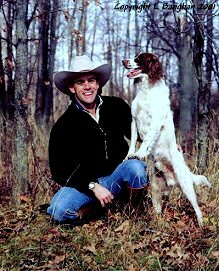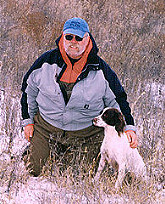The National English Springer Spaniel
Shooting Dog Championship
by Bob Sansom

I had the opportunity to attend and compete in a first ever event: the National English Springer Spaniel Shooting Dog Championship, held outside Victoria Texas. This event came about as a result of discussion, and strong argument on the merits of field trials and whether or not trial dogs really best represent what
the English Springer should be. Most of us who field trial believe the trial dog is a hunting dog par excellence' beyond the average, and so represents the best of the breed, but there are those who question this. The doubters see trials as a specialty event where speed and flash carry more weight than finding and handling. They may have witnessed a trial (or usually heard of one) where a dog that handled poorly on a
retrieve or was out of control, placed in a particular trial. From limited knowledge about trialing and the dogs that compete in them, have come erroneous conclusions, based on heresay and rare instances.
David Jones, professional dog trainer and hunting guide, encouraged by many, decided to stage an event that he hoped would bring the various field elements together; hard core hunters, those involved in hunt tests, shooting dog competitors, field trialers; any and all people who know and love the ESS as the greatest hunting dog. He developed a format that he hoped would combine the best attributes of trials with elements
that often the average hunter felt was left out and so untested in field trials.
|
"The handlers would do their own shooting in the third and safe shooting was a top priority."
|
|
The plan he implemented was a three series event with the first two series run like a field trial, with a dog, handler, judge, on either side of a stake line. Designated guns would do the shooting for the first two series. The judging criteria would be similar as used in judging AKC field trials, but some latitude would be granted for completing retrieves, passed birds, leaving early. He felt that the dogs needed to be
tested in a brace situation, but the exactness of steady or what we do to complete a retrieve should be given room for maneuver. The simplest way to describe the overall criteria is: We're hunting. How do we handle this as hunters? Talent needed to be demonstrated, but teamwork between dog and handler was a major factor. Every dog and handler that eventually placed, demonstrated and excelled in this part of the show.
The third series was set up to come as close as a person can to replicating conditions found in a days hunt. Thirty minutes would be granted to each handler and dog to complete a circuit around a 20 acre pond. Twelve to fifteen pheasants and chukars were planted per round, quail had already been released. It was hoped that by placing the game around the pond there would be ample opportunity to demonstrate the dogs in
water retrieve situations. Our field trials most often fail to test this part of our dogs oeuvre, and is often cited by the critics of trials as a serious lapse. To circle the pond meant we would place dogs in every wind condition. The length of time was long enough to test stamina and plenty of birds meant a fair test of mental stability. The handlers would do their own shooting in the third and safe shooting was a top
priority. Safe gun handling was carefully practiced and observed by everyone.
The first two series went off as planned. Each judge kept dogs down until they were totally satisfied that the dog had ample opportunity to show its stuff. There were 24 competitors, all trialers, as no one from the other field disciplines showed. Only two dogs were not called back to the second series. Eleven made the cut to the third. We had three days to compete.
Although the third series was a timed event, I found the pace almost leisurely. Unlike an AKC trial, where the judges presence is felt throughout, here, in the third series, the judges kept a "metaphorical" distance. It was up to the individual team how the hunt and retrieves would be handled, not the judges. They were just along for the show and were not going to interfere unless something unsafe happened or the handler
seemed to be at a loss as to what to do next. As one of the fortunate ones to go to the third series, I was nervous at first; not for the dog work but for my shooting! In training all week I had shot dismally, and until I made my first kill I would worry about it. After talking with others, this part was common amongst us; we all were confident in our dogs, just not ourselves!
It became apparent in short order that this competition would be close. No one dog went all the way through clean. When you test as thoroughly as this competition did, you are going to see missteps along the way, but more importantly, you also see spaniels given the chance to excel and this they did! The judges Jerry (Ray) Cacchio and David Jones were not out to eliminate by mistakes but judged based on the total performance
of handler/dog. Unlike some shooting dog competitions, this was not about how many birds you killed or how fast, or how many shells you used; this was about dog and handler working together as one, bringing game home in a sporting, honorable, talented fashion.
Every run was exciting to watch with more than a few making deep impressions. Mhari Peschel overcame some early control problems with Dru (AFC Larsford Storm MH) to eventually be one of only two who actually made it all the way around under 30 minutes, finishing with a nice find and shot of a quail. The gallery could not help itself but to applaud these two. Mhari and Dru's performance was recognized with a Certificate of Merit.
Shaman, (FC AFC CFC Skaar's Whitlock's Warlock, who achieved his NAFC title later that year) and John Wright, showed once again why Shaman was high point Open dog the previous year. Shaman, overcoming sickness, once again put on a great show of bird finding, retrieving and most especially, teamwork. These two received a 4th.
|
"...this was about dog and handler working together as one, bringing game home in a sporting, honorable, talented fashion."
|
|
Third place dog was Sally (Marsan Sally) and Paul Black. Sally found every bird of hers plus some left over from other dogs and Paul put each find in the basket. They also finished the course and ended it with a long retrieve, buttoned by Sally; Paul was ecstatic!
"Awesome" George Keiller, and Lass (AFC Strong's Lass of Suthron Glen) finished and received an Honorable Mention, as did I with my Lilli (CFC Winter Winds Diamond Lilli).
The show of the weekend was put on by the eventual 1st place winner, Parker and Bird Dog Hall of Famer, Dan Langhans. Dan, who normally keeps his dogs in a tight, controlled pattern, allowed Parker (FC CNFC Parker Sir Roberts) to open up and it paid dividends in outstanding finds and retrieves. Early on Parker needed to find a wounded chukkar that disappeared over a slight rise, towards and maybe in the pond. Parkers line
was excellent and when he didn't find it in the first possible location, returned to his line and swam out to a point of land, searched there, entered water again to swim to the next point of land, eventually finding the bird on shore where it had run. This team got to show off brains as well as bird finding, and so edged the solid work of Jolly to second place.
Jolly's run (FC Denalisunflos Jolly) with Pro Jim Devoll at the controls, showed the classic consistent bird work that Jolly is known for. It was said if he could of had the chance to show off as Parker did, the placements may have been different.
This event reminded many of us of the importance of the total dog; not just a dog that can run fast or find big, but a dog that can do it all, in any situation and do it with style and under control! There were many water retrieves and every dog in the third showed they were comfortable retrieving there. I noticed most handlers were quieter than you normally would see in an AKC trial. I have always been an advocate of judging
dog talent first and control is noted normally by me when it's lacking, or so absolute you cannot ignore it. In this event, control and rapport was very important and has given me pause to think about my own criteria. It sure was a pleasure to watch talented animals and handlers show off their best, in a quiet sportsmanlike manner.
We who judge AKC trials take note: Jerry and David did not just process dogs through, but tested thoroughly. Time constraints in large trials has made it extremely difficult to do this. I realized more than ever we need to figure out a way to make our entries manageable and so be able to truly be positive in our assessments.
I had a great time! I recommend it to everyone who loves to see our English Springer Spaniels at their absolute best!
Note: Article first appeared in Spaniels Online in 2000 - reprinted with the permission of the Author.
For Further NESSSDC Information:
|
|

|
Bob Sansom is a professional trainer, handler, and field trial judge. He owned, trained, and campaigned NAFC Winter Winds White Knight, also known as Duffy.
He breeds field trial and gun dog springers at his Winterwinds Kennels. Bob is the founding member and President of the Tilden Valley English Springer Spaniel Club. He resides near Marquette, Michigan.
|
|



